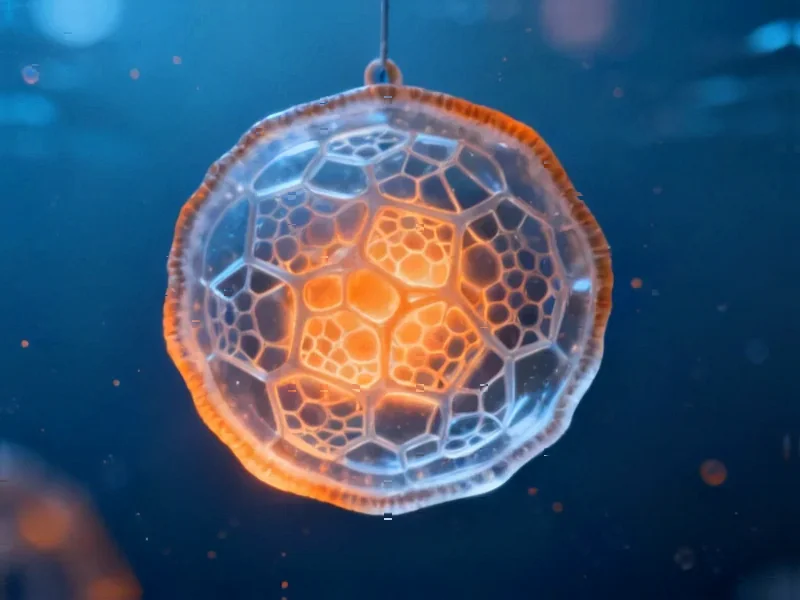Revolutionary Fabric Technology Transforms Isotope Separation
In a significant advancement for industrial separation processes, researchers have developed a porous molecularly woven fabric that enables dynamic separation of water isotopologues at room temperature. This breakthrough technology addresses one of chemistry’s most challenging separation problems – efficiently isolating heavy water (D₂O) from regular water (H₂O) – and could transform multiple industries from nuclear energy to medical applications.
Table of Contents
The Heavy Water Challenge
Heavy water represents a critical strategic resource with applications spanning nuclear reactors, medical diagnostics, and fundamental scientific research. However, its natural abundance of only 0.015% makes high-purity extraction exceptionally difficult. The near-identical physical and chemical properties of H₂O and D₂O, including matching kinetic diameters and similar chemical behavior, have rendered traditional separation methods prohibitively energy-intensive.
Current industrial separation techniques, including distillation, electrolysis, and chemical exchange processes, consume substantial energy due to the minimal thermodynamic differences between the isotopologues. This energy penalty has driven decades of research into more efficient separation methodologies that could reduce costs and environmental impact.
Molecular Weaving Innovation
The newly developed porous molecularly woven polymer (PWPN-1) represents a paradigm shift in separation technology. Inspired by macroscopic woven materials used in filtration and separation applications, the material features a three-dimensional weaving network constructed through mortise-and-tenon stacking of two-dimensional molecularly woven layers., as our earlier report
This unique architecture creates woven channels that serve as transport pathways while adaptive woven and mortise-and-tenon nodes enhance selective adsorption. The material’s flexibility allows it to dynamically respond to the subtle differences between water isotopologues, particularly variations in hydrogen bonding strength, which conventional rigid porous materials cannot effectively exploit., according to recent studies
Dynamic Separation Breakthrough
What sets this technology apart is its ability to perform dynamic co-adsorption separation – a process where isotopologue mixtures flow through packed columns under pressure. Previous approaches using porous materials like metal-organic frameworks and covalent organic frameworks have achieved only static separation, where materials are immersed in isotopologue mixtures.
The dynamic separation capability makes the technology particularly valuable for industrial applications, as it enables continuous processing rather than batch operations. At 298 K (room temperature), the molecularly woven fabric successfully separates H₂O and D₂O by amplifying their subtle diffusion differences as they travel through the three-dimensional network.
Industrial Implications and Applications
This advancement holds significant promise for multiple sectors:, according to market developments
- Nuclear Industry: More efficient heavy water production for moderator and coolant applications
- Medical Field: Improved access to deuterated compounds for diagnostic and research applications
- Chemical Manufacturing: Enhanced isotope separation for specialty chemicals and pharmaceuticals
- Energy Sector: Reduced energy consumption in separation processes
The room-temperature operation and pressure-driven process suggest potential for scaling to industrial production levels, addressing one of the major limitations of previous separation technologies.
Future Development Pathways
While the current research demonstrates proof-of-concept for water isotopologue separation, the molecular weaving approach could potentially be adapted for other challenging separation applications. The adaptive nature of the woven structure suggests possibilities for separating other chemically similar compounds where subtle differences in molecular properties have traditionally made efficient separation difficult.
Further research will likely focus on optimizing the weaving topology for specific industrial applications, scaling up production of the molecular fabric, and exploring modifications to target different separation challenges across various industries.
The successful demonstration of dynamic co-adsorption separation using molecularly woven materials marks a significant milestone in separation science and could pave the way for more energy-efficient industrial processes in multiple sectors.
Related Articles You May Find Interesting
- The Hidden Cost of Corporate Profit Demands on Xbox’s Future
- Reddit Escalates Legal Battle With Perplexity AI Over Alleged Data Theft Scheme
- Market Jitters Grow as Tech Stocks Falter and Retail Sentiment Softens, Analysts
- European VC Giant Lakestar Shifts Strategy: From Fundraising to Portfolio Maximi
- European VC Giant Lakestar Shifts Strategy: From Fundraising to Portfolio Maximi
This article aggregates information from publicly available sources. All trademarks and copyrights belong to their respective owners.
Note: Featured image is for illustrative purposes only and does not represent any specific product, service, or entity mentioned in this article.



